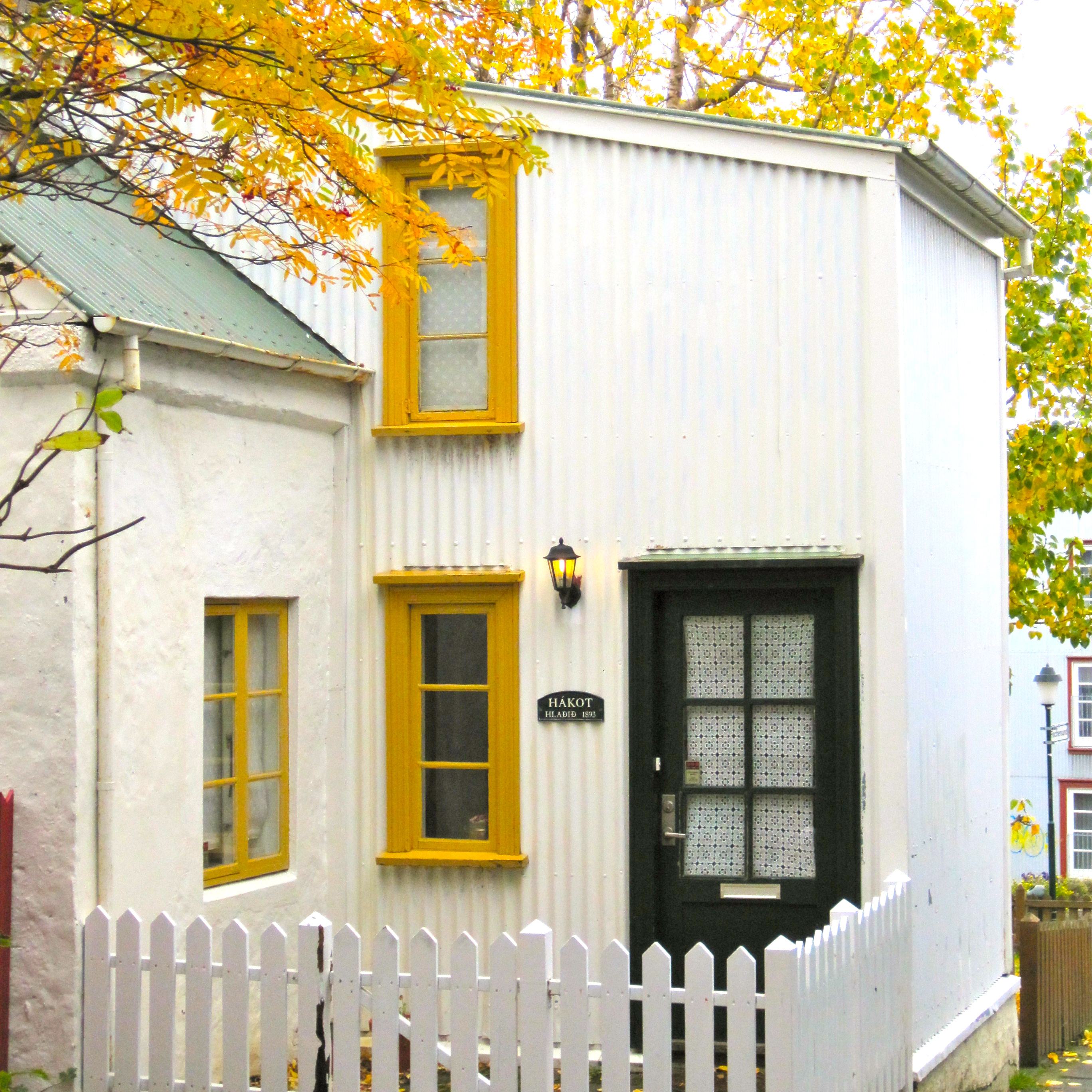
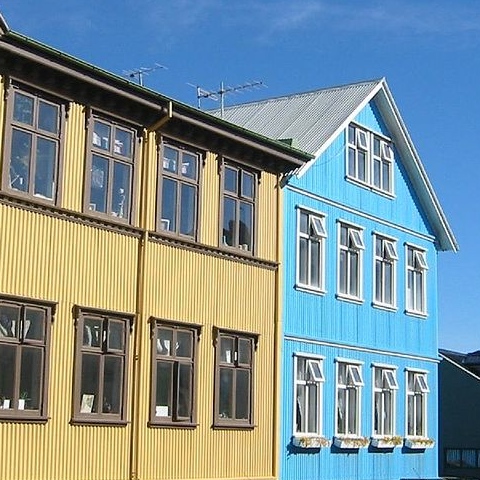
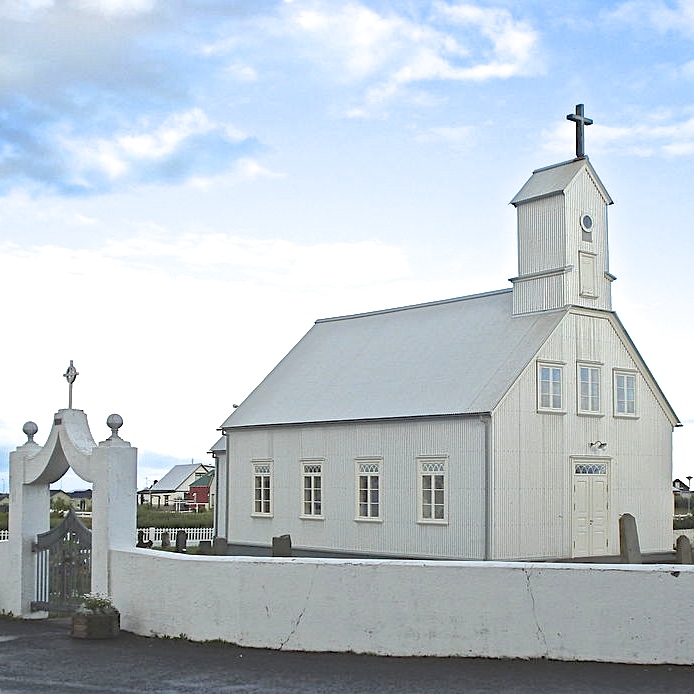
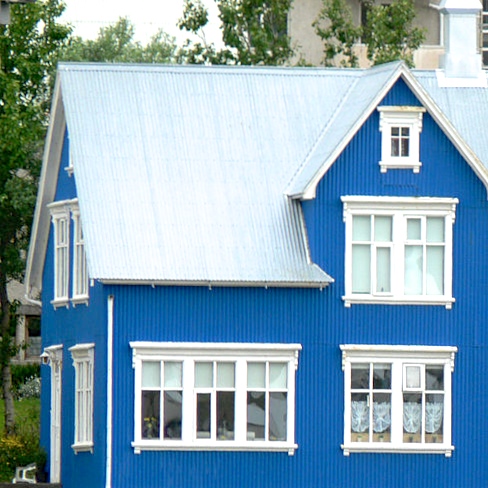

Iceland is well known to travelers for its many splendors. From its glaciers and lava fields, to its geothermal spas and northern lights, Iceland will not disappoint. But few tourist brochures mention Iceland’s fascinating architecture.
It’s thrilling to encounter common materials used in unexpected ways. Such is the case with Icelandic architecture. Many of the homes, churches, and commercial buildings employ the whimsical Swiss chalet style, with a twist …
They are clad in corrugated metal – the siding and the roof! Many are painted in bright colors; others are left in their natural state, adding that gritty urban vibe.
From impressive mansions …
… and businesses …
… to rustic cottages …
… and churches, affectionately known as “tin tabernacles.”
As a kid growing up in the USA, I thought corrugated metal was strictly utilitarian. Any trip to the countryside guaranteed sightings of metal chicken coops and grain silos, their wavy ridges glimmering in the sunlight.
Who could have predicted the ruffled iron would reach its current level of architectural notoriety. Who knew corrugated metal could be so cool!
So What’s the Story?
Converts have been singing the praises of corrugated metal for years. Thanks to its high strength-to-weight ratio, it is lightweight, durable, economical, fire-resistant, moisture-resistant, and a good choice for areas that have termite infestations (probably not a problem in Iceland). Invented in the 1800s, it continues to stand the test of time.
The use of corrugated metal in Iceland came about as a response to natural disasters (volcanos, floods, and earthquakes), scarce wood supply (decimated by the Vikings), and catastrophic fires that ravaged the cities.
“Ships travelling north from Britain to buy sheep would carry cargoes of corrugated iron to sell in Reykjavik, where it quickly became clear that the material was well suited to the isolated volcanic island with limited local construction materials.” —Lloyd Alter, Managing Editor of Treehugger
And although there’s a thoroughly scientific explanation for the wavy look of corrugated metal, others among us might believe it was inspired by Iceland’s “columnar jointing.”
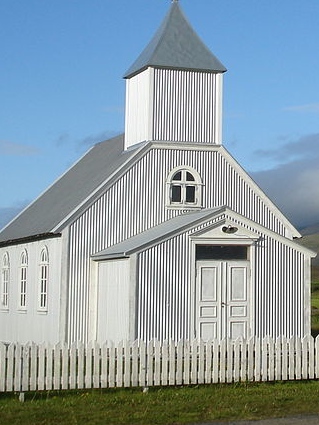
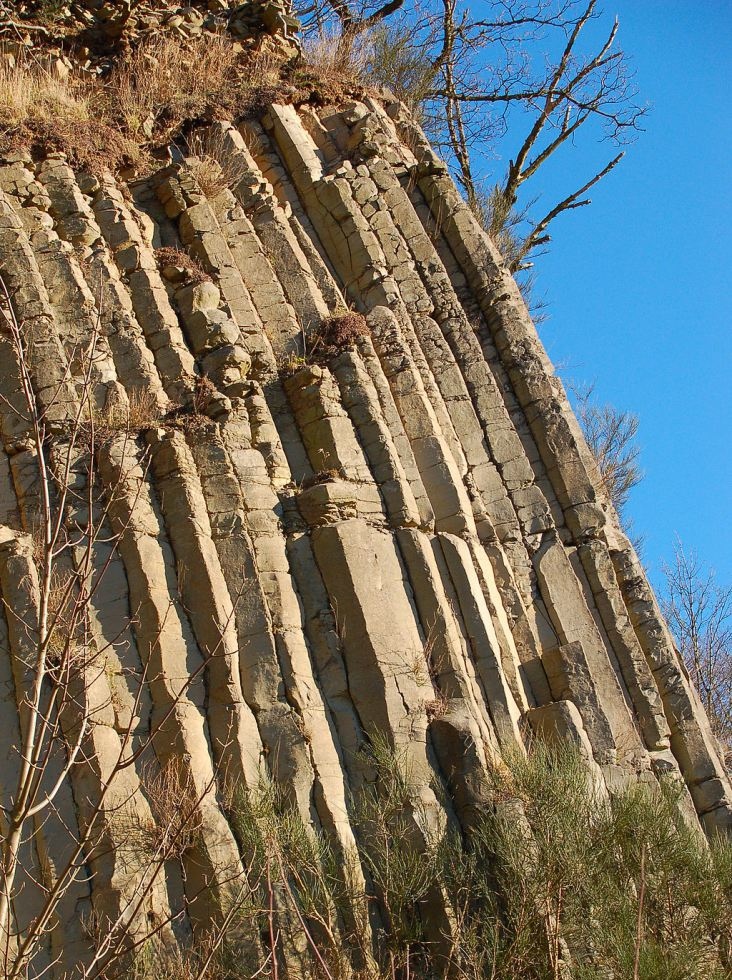
Corrugated metal may have started its life as a utilitarian building material, but it’s gone from practical to spectacular, functional to fantastic, ho-hum to Wow! The result is surprisingly fresh and appealing.
Enjoy the “Waves,”
Terri
Last Updated September 6, 2023
Photo Credits: 2. WorldIslandInfo.com 4,5. Christian Bickel 10. Ouicoude 14. I, Eysteinn Guðni Guðnason 15. Johann Dréo


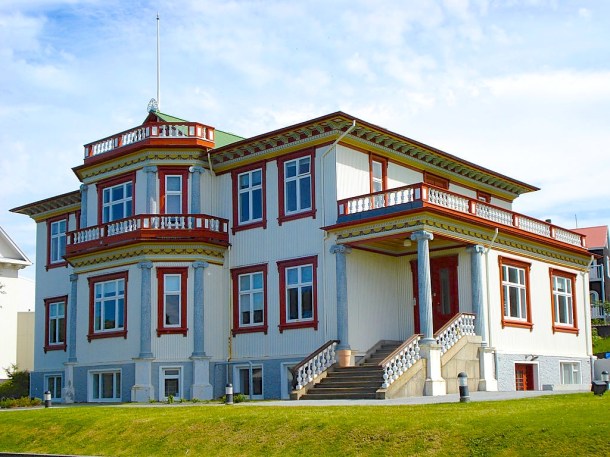



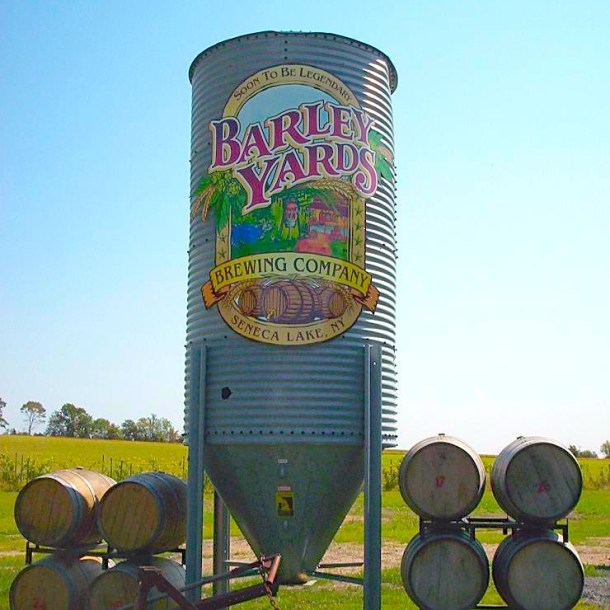

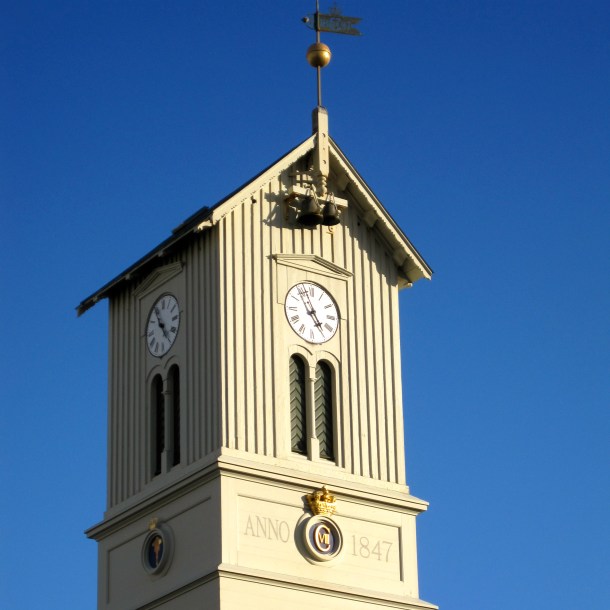
I can always count on the two of you to bring a unique look at a destination. Corrugated metal as the mail building material. Who knew? Who can resist something called the ‘Tin Tabernacle’? That will be in my head for days. 🙂
Thanks so much, Sue! I just love the term “tin tabernacles. ” They evidently started in Britain and were often pre-fabs. How is corrugated metal used in Canada? ~Terri
Well that is a good question and I bet varies a great deal across this wide expanse of land. I have seen it used for roof tops on the prairies primarily.
What an interesting post, James. I had no idea that corrugated iron was used as a building material in Iceland, or anywhere for that matter. It is quite attractive. Thanks. –Curt
Many thanks, Curt. My grandmother lived in the country and she had several outbuildings that were covered in corrugated iron. As kids we would practice our morse code by tapping on the walls to see if my cousins could figure out the message. I was so surprised when I saw my first corrugated house in Reykjavik that I did a double take. 🙂 ~Terri
I’m hooked on the ‘wave’. I always thought attractive and it really is here, when painted those pastel blues. I wonder what kind of paint they use on the metal that it adheres and doesn’t blister and peel?
That is a great question, Tess. I couldn’t find a definitive answer about the paint, but most people seem to think that it’s some kind of marine paint designed to withstand the weather. That’s some pretty strong stuff! 🙂 ~Terri
Well I’ve seen galvanized steel like these ‘waves’ painted and peel,therefore the question. It’s clear the people of Iceland have a solution. 😀
Tess, hopefully someone who knows the right answer will chime in. Calling all Icelandic painters … 🙂 ~Terri
Hahahahahahaha
When I was a boy there was post war council housing estate in our town that were made from corrugated steel. It was a real stigma to live in what was known locally as ‘Tin Town’.
I liked those buildings in Iceland, if I lived there I’d have one because I am sure there would be much less painting!
How interesting, Andrew – I’d never heard that. As a girl in small town America, the equivalent was to come from “the other side of the tracks,” but I don’t think there were any tin houses. Most of the urban corrugated steel was used by the military and for industrial installations.
I’m with you on the Iceland houses because I definitely like the idea of less painting! 🙂 ~Terri
Have you been to Portugal? There are a lot of tin houses there.
That’s right, I remember now, but I can’t recall if they are painted.
Usually very brightly.
I am absolutely enthralled by the idea of visiting Iceland. It shouldn’t be too hard for me to do now… just a little hope, skip, and a jump away. 🙂 Your post makes it look even more inviting and appealing. Thank you!! Happy Monday to you both!
Thanks Liz! You will really enjoy Iceland. And if you fly Iceland Air, they allow a free stopover, so it’s the perfect thing to do on a trip back to the States. We’ve done it a couple of times and think it’s one of the coolest places. 🙂 How are you adjusting to being back? ~Terri
How cool. I’ve used it as a roofing material. Even with our snowy, wet winters it holds up well. I’d never have thought such beautiful buildings could be sided with it.
I agree, Laura. I always perceived corrugated metal as a cold, practical material – until I saw it used in Iceland. Their little cottages enthralled me, and I couldn’t believe all the mansions that were sided with it. I definitely developed a whole new appreciation for it. ~Terri
Very cool. We’re just booked a 4 day trip to Iceland on our way back from the US this summer. Very much looking forward to getting off the grid and getting into some tin! Love the photos!
That’s great Dina! You are going to have a blast. It’s such a different place with a rich history and amazing natural wonders. Are you starting out in Reykjavik, then branching out? ~Terri
We’ll probably spend half a day in Reykjavik and then we’re off to the countryside. Volcanoes, hot springs and no wifi!!
Woohoo! Sounds like the perfect trip. Enjoy! ~Terri
Love this! Great story & photos.
Many thanks EW. Given your heritage, is this a building material that’s used where you’ve lived? ~Terri
Hi Terri,
Varies by region, but given the available natural resources, lots of (gorgeous!) wooden architecture and traditions. When we roofed and sided our barn/studio in VT a few years ago we went with corrugated, and hope to do the same on the house some day. A great look, and so practical. Love the mix of traditional and metal that the Icelanders have embraced, very cool!
-Elin
I have long been a fan of those gorgeous wooden structures you mentioned. And thanks to Iceland, I’m now a fan of corrugated metal. I also follow the “tiny house community” and they’re using corrugated on many of their little houses. I bet your barn/studio looks wonderful. Is there a photo of it on your blog? ~Terri
The only down side to metal roofs here is the wood peckers who beat on it to call for a mate in the spring!
LOL Martha! That’s too funny. I didn’t realize they were doing it to call for a mate. A similar thing happens where we live because there are a lot of metal, standing-seam roofs that the woodpeckers are drawn to – now I know why! 🙂 ~Terri
We can use termite proof houses here in SW Florida. I believe you’ve found it. Interesting post. Food for thought. 🏡
Lynne, we also used to live in Florida, and I know what a pain in the neck termites can be. They pretty much destroyed our screen porch. Wish we had known about this use of corrugated metal. 🙂 ~Terri
Beautiful!
Thanks. The little cottages really captured my heart. Have you seen corrugated metal used this way in your travels? ~Terri
Interestingly enough I have seen it a lot in rural California. Ranchers and farmers use it to make outbuildings, sheds, shops, etc. nothing like hearing rain on a tin roof!
Oh you are so right about the rain. My grandmother had a tin roof and I thought the sound of rain on it was magical. I also remember the roof did a lot of popping in the summer as it was heated up by the sun.
What a great use for ordinary building material. I always think of Quonsets when it comes to corrugated metal. They were very popular in the Canadian prairies while I was growing up. Dad had one to store his farm machinery in.
You’re right Darlene! I’d totally forgotten about Quonsets. I grew up near a large farming area (affectionately known as “The Muck”) and I remember lots of Quonsets used for the same purpose. Thanks so much for jogging my memory. 🙂 ~Terri
This was really fascinating. I’m looking forward to seeing it myself this summer 🙂
I’ve always associated corrugated steel with farm buildings, large garages etc. This is really novel. I too am curious as to how the paint doesn’t peel. 🙂
Thanks Joanne, I had the same impression until I went to Iceland. It’s great you’re going there this summer. We want to go back and explore some more. Do you have your destinations all figured out? ~Terri
Hi Terri – unfortunately we are there for only a weekend. We decided to do a layover on our return from Sweden/Denmark/Norway.
What I would like to do vs the time available are 2 very different things. I’m looking forward to the Whale Museum, but if you have any ideas for the general Reykjavik area, I’d love to hear them!
Joanne, Like you we’ve done some of the free Iceland Air stopovers (wonderful) and had a blast. In Reykjavik we loved just walking around he neighborhoods. Also the cathedral and opera house. We really wanted to go to the Open Air Folk Museum, but we were there off-season and it was closed. It should be open for your visit. One of the best blogs I’ve seen on Iceland is Naturetime by Pam and Richard – gorgeous photos and fabulous ideas. Here’s a link to all their posts. Have fun! 🙂 ~Terri
https://naturetime.wordpress.com/?s=iceland
Thanks for the feedback. This is the first time we’re doing this stopover. Quite frankly, it never occurred to us until a friend suggested it. I’m really looking forward to it!!
Thanks for this link. It looks amazing and I’ll have to spend some time perusing it 🙂
I love all the colors! Brightens up the urban landscape.
Pam, your excellent Iceland posts are such an inspiration. 🙂 When I saw them I knew I had to go back and explore some more – especially to see the horses and sod houses. ~Terri
We’ve got to go back!!!
As usual, your photos add much to your narrative. For an island nation known for its fire and ice, you brought in a lot of color to help tell the story. Great job, as usual. – Mike
Thanks so much Mike. We were truly surprised by the colorful exteriors of the buildings, and amazed that the corrugated metal was used on cottages and mansions alike. Talk about mind expanding. How are you and Florence doing? I hope you’re starting to see signs of spring. 🙂 Are you and Florence blogging at a new site these days? ~Terri
Hi Terri. Spring came early this year after a temperate winter and the 2nd worst snowfall on record for the Northwest. We are enjoying our retirement near the grandchildren.
We haven’t been blogging since we took a break from traveling. However, I am getting involved in the environmental movement and I may be writing more about climate change and politics, specifically about resisting oil and coal development which is heavily targeting our region. Thanks for asking. – Mike
That sounds great, Mike. It’s an important issue, and knowing that people like you are involved is exciting … and reassuring. We miss your blogs, but definitely understand that life goes in cycles – we’re living proof! 🙂 All my best to you and Florence, Terri
Yet again, Iceland continues to amaze me! I never knew about the corrugated metal construction there! So beautiful!
Thank you again for sharing this fabulous country with us!
You are very welcome, Lia. It’s a beautiful, fascinating country for sure. Is it on your wishlist? ~Terri
Thank you, Terri! Indeed Iceland is on my list… It’s a short flight from New York but so exotic and interesting!!
I lived on a “hobby farm” for 18 years, and during that time built four outbuildings with metal roofs (all red, BTW). I love the stuff, especially for roofing, where rain can make music if you listen for it.
I love your term “hobby farm,” Tom. My Dad did the same thing, except he called it “Carefree Acres.” Not! Did you have to paint the roofs red, or did the metal come prepainted? I too love the sound of rain on a tin roof – my grandmother had one. Loved it! Are you enjoying being back home? ~Terri
Terri, the paint is baked on at the factory. And yes, we’re happy to be back home. We’re wrapping up a year of the ritzy life in downtown Portland (minus three months while we were in France), and will take up permanent residence in a Portland condo we own in a couple of weeks. Finally, a home base, following the Vance’s advice.
That’s fantastic Tom. I can’t wait to read all about it, with lots of photos I hope. 🙂 We’re getting ready to make a big life change, too. Isn’t life fun. ~Terri
Such an interesting post Terri. I had no idea that corrugated metal was such a popular building material anywhere in the world. I wonder if this is something any builder or architect in our country has considered?
Hi LuAnn, it’s so great to hear from you. Great question. Several readers have talked about the use of corrugated metal in North America, particularly in the northern US and Canada. When I was researching the topic, I came across several contemporary uses in modern homes. One of the most interesting websites is by the Home Depot company! Here’s a link. How are you and Terry doing? All the best, Terri
http://ext.homedepot.com/community/blog/meet-the-material-corrugated-sheet-metal-at-home-depot/
Thanks Terri. I will have a look. Terry and I are well. He is back in Ohio getting his mother moved out of her home and into an independent living facility. We are thankful she finally sold her house.
That’s good news about Terry’s mother. These life transitions and changes are so challenging, I’m sure she’s comforted by his help and presence. So where are you “holding down the fort?” ~Terri
I am in Jojoba Hills near Temecula, CA. Getting ready to hit the road near the end of the month. 🙂 Are you two at home right now?
I know how much you’ve enjoyed Jojoba Hills, LuAnn. It looks and sounds like a fabulous place. We are here at home on St. Simons Island, GA, but we too are planning a big move next week if everything works out OK. Hopefully we’ll be making a big announcement next week. 🙂 Where are you two heading when you leave Jojoba Hills? ~Terri
We are heading up the 395 into the Sierras, something we have not done in the spring before, then over to Ashland and Bend, OR, then on into Washington, the San Juan Islands for a month, then hopefully, if the weather permits, on to Banff and Jasper. I’m looking forward to your next move. Whatever it is, I know it will be quite the adventure. 🙂
LuAnn, that sounds fantastic! We used to live in Oregon (Eugene and Newport) and loved the time we spent in the San Juan Islands. James has been to Banff on business and raved about it. Sounds like a wonderful spring and summer. Can’t wait to read all about it. 🙂 ~T
We love Eugene and Newport and are planning to do more exploring in central OR this summer.
Really enjoyed your photos and narrative – what an interesting aspect of Iceland. I’ve always associated corrugated metal homes with poor parts of the world so thanks for breaking that stereotype!
Thanks! It’s always fun to break stereotypes. 🙂 And I was just as surprised as you to see the corrugated metal used in such creative ways. I love it when someone finds a new use for a material. My favorite example comes from when we lived in Sudan. The women there took multi-colored telephone wire and wove it into beautiful baskets and jewelry. I bet the person who invented the wire never imagined it would be used that way. 🙂 ~Terri
These look so crisp, clean and stylish — you’d never know they were constructed from corrugated steel. Must be a fast building method. Maybe there’s a lesson there for other countries with housing shortages.
Great description, Dorothy – crisp, clean and stylish. You definitely hit the nail on the head! I love the little painted cottages, but I must admit I was really fascinated by the house that left the metal unpainted and added the fancy, brown windows. The contrast was stunning. 🙂 ~Terri
Fantastic photos. Thanks for the preview of Iceland.
Many thanks, Shelley. Are you heading to Iceland soon? ~Terri
We are going in July, with Overseas Adventure Travel.
I enjoyed learning about the tin tabernacles and metal use in iceland – also – I gather format he seneca lake photo that you might have roots in NY – I do too – but we were a little closer to lake erie – anyhow, I also did not know that Iceland had geothermal spas – what a mix of things to find there.
Thanks for the comment and for dropping by the blog Yvette. No, we don’t have roots in NY, but it’s one of our summer destinations for camping. We’ve spent a bit of time around the Fingerlakes, which is a wonderful area. ~James
thanks James – and I have never been to the finger lakes – but many people do not realize how gorgeous New York State can be- whew – have a nice day
Your beautiful photos make me think that one day I want to see Iceland. This country definitely calls me. Thank you for inspiring me.
Thanks for the comment Cecilia and for dropping by the blog. Iceland is a unique place and has so much natural beauty to see. If you can swing it, you would really enjoy a trip there. I hope that you can work it out. ~James
Not yet been there, but Your great post gives ideas for…
I know you would love it because it’s a photographer’s dream! 🙂 Terri
Love it!
Corugated cladding has been very popular in Australia for housing for many years now as well 😉
Chris, I saw that Australia uses corrugated cladding when I was researching the topic. Is it used on all types of buildings, including residences, or reserved for utility building like here in the US? ~Terri
Used on both. Once upon a time it was purely for roofing, however that utility look is quite in vogue, so we now see it on both commercial & residential properties 🙂
Hi Mark,
Many thanks for linking to my article about Iceland’s Quaint Corrugated Construction. I was fascinated by your article and didn’t realize that Icelanders had grown ashamed of their turf houses, equating them with backwardness. I’m glad to see that young people are more receptive to the concept. I think that generations of Americans have had the same attitude toward corrugated metal structures, but young U.S. architects are now embracing the material, deeming it hip.
You’re a joy to read. Thanks again.
All the best,
Terri Vance
Wonder if it rains, it’s noisier. Interesting as structural material better in earthquake zone. I can’t imagine Vancouver BC adopting this. (By the way, have you been to this part of Canada?)
Jean, my grandparents in the US had a tin roof, and it is definitely noisier when it rains. But unless it rains very hard, the pitter-patter is actually very comforting. We lived in Oregon for a while and while there, we took the ferry through the Juan de Fuca (excellent) to Victoria, and then Vancouver. It was a wonderful trip and unlike anything we had seen before. You live in a beautiful part of the world. ~James
This is such a unique perspective on the picturesque buildings in Iceland! I have photographed many of these scenes without ever once thinking about the building materials. Maybe I should read your blog before traveling to all my destinations in the future! Off to check whether you’ve been to Colombia … just booked flights last night!
Lexie, I have been to Colombia, and as you might imagine, I have an interesting story. I was working at the time (geophysicist in oil exploration), and visited a few times. I was there some years ago, and the last time I was there, I had to scout a location for some field work in the Magdalena Valley, which just happened to be in prime narcotics and revolutionary country. The US embassy said “you do NOT want to go to that area. The narcos could mistake you for DEA, and the guerrillas might kidnap you for ransom.” The interesting part is that I had a body guard the whole time I was in country. It was a strange experience that I don’t want to have again. I’ll look forward to your posts. ~James
Having only seen it, as you mentioned, in rural and industrial areas in the US, I never imagined it could look this good in use.
Hi Dan, I was as surprised as you. My first thought was, “What a cool house.” And then I realized the material was corrugated metal. Well, that’s interesting – and I started seeing them all over Iceland. I’m hooked! But I’m sure it makes quite a racket in a hail storm! 🙂 So glad you stopped by. All the best, Terri
I too was struck by the corrugated metal building material. Cool
Thanks Bruce! Some of the buildings were so elegant it took me a moment to realize they were clad in corrugated metal. So glad you stopped by. All the best, Terri
I’ve been thinking about building a house made of steel, instead of wood, for a long while. Most of them come with steel siding like in Iceland. Are the ones in Iceland made with steel beams also? THat would make sense.
That’s a great question, BF … and I don’t know the answer. I know that the corrugated metal originally became popular as an exterior cladding that preserved the original timber frames of the buildings (some of them were kit houses imported from Norway). But it would make total sense that newer structures could have steel beams. I’d love to know more about your vision for your steel house. ~Terri
Love this post!
Thanks Nicole. It was so interesting to see corrugated metal used in such a creative way. ~Terri
I loved my visit to Iceland. I really want to go back.
Us too, Nicole. Some friends rented a campervan and explored the countryside. That’s what we would like to do next time. ~Terri
I’m late to the party, it seems! I’ve been watching something that was filmed in Iceland, and I was struck how the buildings were sided with the corrugated metal – did a search on it and voila! It led me here. I didn’t even think about the scarcity of timber as a reason it was used. My initial thought was that it would provide better insulation, especially if used in conjunction with fiber insulation between the metal and the wall of the building. My house has a tin roof (love it when it rains) but never occurred to me that it could be a siding. And yes, we have to repaint it fairly often. We will have to look into pre-painted panels when it’s time to replace it.
Stunning photos! Thank you!
Thanks for the comment Laura and for dropping by the blog. As you can imagine, there are certain realities when living in a harsh environment like Iceland, and one is practicality. But one of the coolest things about Iceland’s corrugated metal buildings is that they have made them attractive as well. It’s the perfect combination. Also, I’m sure the buildings are well insulated, but given its location on the Mid-Atlantic ridge and the abundant volcanism, geothermal heat makes it less of an issue. It’s an interesting island, and must be a unique place to live. ~James
Thanks for the link to our post. Regards, James